View in other NatureServe Network Field Guides
NatureServe
Montana
Utah
Wyoming
Idaho
Wisconsin
British Columbia
South Carolina
Yukon
California
New York
Speckled Range Grasshopper - Arphia conspersa
Other Names:
Speckled Rangeland Grasshopper
General Description
The following comes from Brooks (1958), Helfer (1971), Capinera and Sechrist (1982), Otte (1984), Vickery and Kevan (1985), McDaniel (1987), Pfadt (2002), Capinera (2001), Capinera et al. (2004), Brust et al. (2008), and Scott (2010). This species is highly variable in its overall appearance. The hind wings can be yellow, orange or red with a dark brown to blackish marginal border, but regionally one color tends to dominate. The forewings are brown and speckled, and often have a light yellowish stripe along the anterior edge which forms a light stripe on the medial surface when the wings are folded, and the individual is at rest. The body color is grayish brown with a yellow abdomen in males, often dark brown with the segments bordered by yellow in females. The median carina (ridge) on the pronotum (thorax) is distinct, but only slightly elevated with a single incision slightly forward of the middle. The inner face of the hind femur is blueish-black with 3 pale yellowish markings on the dorsal surface, the anterior one forming a light ring near the terminal joint (knee). The hind tibia is dark brown or bluish-black with a pale ring at its basal third. Note that these characteristics can be variable depending upon regional locations within its geographic range.
Communicative behavior/Crepitation*
Both males and females crepitate in flight and when disturbed. Researchers have recorded the rates to about 33 crepitations per second, plus hind femur tipping and raising when on the ground, and producing “chirps” by stridulation*, especially during courtship approaches and territorial displays (Otte 1970).
*Crepitation is the sound produced by grasshoppers making a clicking or snapping noise with their wings when in flight, during courtship, territorial encounters or being disturbed.
*Stridulation is rubbing one body part against another, usually the hind femur against the forewing in the case of the Band-winged Grasshoppers. This is often used for attracting a female during courtship (Otte 1970).
Phenology
The following is taken from Vickery and Kevan (1985), Pfadt (2002), and Scott journal note (2021). This species overwinters in the 4th or 5th nymphal instar stage. This is one of the first adult grasshoppers in Montana to appear in spring, sometimes as early as the last week of March, due to overwintering in the late nymph stage. Sudden drops in temperature and spring snowstorms only slow their activity. As soon as the temperatures rise, the snow melts and ground temperatures reach about 60° F, they are again active, and crepitating over the landscape. They are present until around mid-July when they die-off and are replaced by the congener
Red-winged Grasshopper (
A. pseudonietana).
Diagnostic Characteristics
The following comes from Brooks (1958), Helfer (1971), Otte (1984), Capinera and Sechrist (1982), Vickery and Kevan (1985), McDaniel (1987), Pfadt (2002), Capinera (2001), Capinera et al. (2004), and Scott (2010). The male body size is 20-25 mm, and female’s 30-37 mm. The hind femur length in males is 11-12.2 mm, and for females 14-17 mm. The number of antennal segments for males is 23-25, and for females 24-25.
This species can possibly be confused with the
Red-winged Grasshopper (
A. pseudonietana), as that species usually inhabits the same habitats, but occurs as an adult in July. However, there could be some time overlap under certain conditions (Scott journal note 2021).
Species Range
Montana Range
Range Descriptions
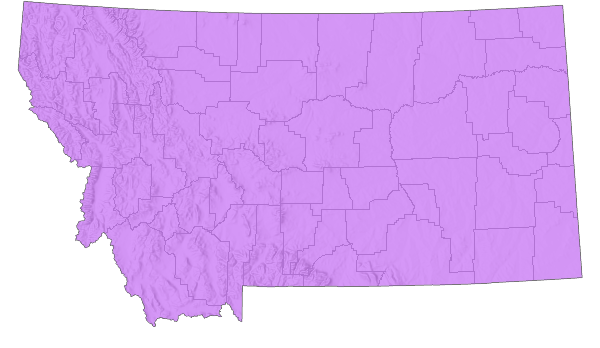
 Native
Native
Range Comments
This species is widely distributed across the western half of the U.S. and the Canadian Provinces. It occurs from Alaska, southward into more than half the mid-regions of Mexico. From the West Coast, it is distributed eastward to western Wisconsin and upper-western peninsula of Michigan. In Montana, it has been recorded for 28 counties, but probably occurs statewide in suitable habitats (Hebard 1928, Capinera et al. 2004, Otte 1984, Pfadt 2002, and Scott 2010).
Observations in Montana Natural Heritage Program Database
Number of Observations: 38
(Click on the following maps and charts to see full sized version)
Map Help and Descriptions
Relative Density
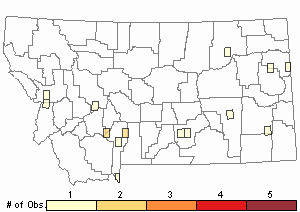
Recency
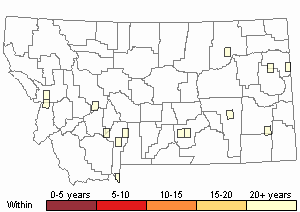

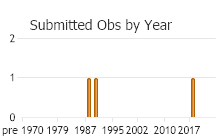
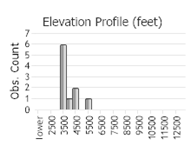 (Observations spanning multiple months or years are excluded from time charts)
(Observations spanning multiple months or years are excluded from time charts)
Habitat
Inhabits a wide variety of communities wherever grasses constitute part of the vegetation, such as all prairie and grassland types, forest openings, mountain meadows, shrubland steppes, and alpine areas up to 11,000 feet, especially those with gravelly or sandy soils (Otte 1984, Vickery and Kevan 1985, and Pfadt 2002).
Food Habits
The Speckled Range Grasshopper feeds mainly on grasses and sedges. Observations indicate that it includes at least 16 species of grasses and 3 species of sedges (preferring Stipa, Agropyron, and Carex species) depending upon the presence and availability of species within the diverse habitats it occupies. It will also consume small amounts of forbs, fungi and other arthropods (Otte 1984, Vickery and Kevan 1985, and Pfadt 2002).
Reproductive Characteristics
Courtship occurs on the ground. A male, detecting a female up to 2 feet away, moves toward her in a series of short running spurts, pausing and stridulating with one to three chirps, and repeats the process until he is within one inch of the female, facing her head-on. They wave their antennae at each other, the male continuing to chirp and moving to her side, sometimes butting her thorax. Continuing to chirp, the male places his front tarsus on her middle leg femur and stomps the ground with his hind tarsus, followed by a series of 4-5 chirps, mounts the female from the rear and copulates. Length of compilatory time has been observed to last about 23 minutes. The female deposits her eggs in bare soil about 2 inches deep, laying 20 to 21 eggs per pod, which is light brown to brown and 4.5-5.2 mm long. The eggs are non-diapause and hatch within about 40 days. The hatching nymphs develop quickly. One study found that in a mixed-grass prairie, at 5000 feet, they reach their 3rd instar stage by late August and the 4th and 5th instar stages by late September, which overwinter and emerge as adults in early spring. There is one life cycle per year, two years at higher elevations and latitudes (Otte 1970 and 1984, and Pfadt 2002).
Stewardship Responsibility
References
- Literature Cited AboveLegend:
 View Online Publication
View Online Publication Brooks, A.R. 1958. Acridoidea of Southern Alberta, Saskatchewan, and Manitoba (Orthoptera). The Canadian Entomologist (Supplement 9) 90:5-92.
Brooks, A.R. 1958. Acridoidea of Southern Alberta, Saskatchewan, and Manitoba (Orthoptera). The Canadian Entomologist (Supplement 9) 90:5-92. Brust, M.L, W.W. Hoback, and R.J. Wright. 2008. The Grasshoppers of Nebraska. Lincoln, NB: University of Nebraska Extension Service, APHIS.
Brust, M.L, W.W. Hoback, and R.J. Wright. 2008. The Grasshoppers of Nebraska. Lincoln, NB: University of Nebraska Extension Service, APHIS. Capinera, J.L. 2001. Handbook of vegetable pests. Orlando, FL: Academic Press. 800 p.
Capinera, J.L. 2001. Handbook of vegetable pests. Orlando, FL: Academic Press. 800 p. Capinera, J.L. and T.S. Sechrist. 1982. Grasshoppers of Colorado: Identification, Biology, and Management. Fort Collins, CO: Colorado State University Experiment Station, Bulletin 584S. 161 p.
Capinera, J.L. and T.S. Sechrist. 1982. Grasshoppers of Colorado: Identification, Biology, and Management. Fort Collins, CO: Colorado State University Experiment Station, Bulletin 584S. 161 p. Capinera, J.L., R.D. Scott, and T.J. Walker. 2004. Field Guide to Grasshoppers, Katydids, and Crickets of the United States. Ithaca, NY. Cornell University Press.
Capinera, J.L., R.D. Scott, and T.J. Walker. 2004. Field Guide to Grasshoppers, Katydids, and Crickets of the United States. Ithaca, NY. Cornell University Press. Hebard, M. 1928. The Orthoptera of Montana. Proceedings of the Academy of Natural Sciences of Philadelphia, Vol. 80:211-306.
Hebard, M. 1928. The Orthoptera of Montana. Proceedings of the Academy of Natural Sciences of Philadelphia, Vol. 80:211-306. Helfer, J.R. 1971. How to Know the Grasshoppers, Crickets, Cockroaches, and Their Allies. Revised edition (out of print), Mineola, NY: Dover Publications.
Helfer, J.R. 1971. How to Know the Grasshoppers, Crickets, Cockroaches, and Their Allies. Revised edition (out of print), Mineola, NY: Dover Publications. McDaniel, B. 1987. Grasshoppers of South Dakota. Brookings, SD: South Dakota Agricultural Experiment Station, Bulletin TB 89.
McDaniel, B. 1987. Grasshoppers of South Dakota. Brookings, SD: South Dakota Agricultural Experiment Station, Bulletin TB 89. Otte, Daniel. 1970. A comparative study of communicative behavior in grasshoppers. Miscellaneous Publications, Museum of Zoology, No. 141. Ann Arbor, MI: University of Michigan.
Otte, Daniel. 1970. A comparative study of communicative behavior in grasshoppers. Miscellaneous Publications, Museum of Zoology, No. 141. Ann Arbor, MI: University of Michigan. Otte, Daniel. 1984. The North American Grasshoppers Volume II. Acrididae (Oedipodinae). Harvard University Press. 366 pp.
Otte, Daniel. 1984. The North American Grasshoppers Volume II. Acrididae (Oedipodinae). Harvard University Press. 366 pp. Pfadt, R.E. 2002. Field Guide to Common Western Grasshoppers, 3rd edition. Laramie, WY: Wyoming Agricultural Experiment Station, Bulletin 912, modified by S. Schell and S. Schell for electronic publication. Accessed 19 February 2020. http://www.uwyo.edu/entomology/grasshoppers/field-guide/index.html#fieldguidetoc
Pfadt, R.E. 2002. Field Guide to Common Western Grasshoppers, 3rd edition. Laramie, WY: Wyoming Agricultural Experiment Station, Bulletin 912, modified by S. Schell and S. Schell for electronic publication. Accessed 19 February 2020. http://www.uwyo.edu/entomology/grasshoppers/field-guide/index.html#fieldguidetoc Scott, R. 2021. Personal journal note.
Scott, R. 2021. Personal journal note. Scott, R.D. 2010. Montana Grasshoppers, Katydids, and Crickets A Pictorial Field Guide to the Orthoptera. MagpieMTGraphics, Billings, MT.
Scott, R.D. 2010. Montana Grasshoppers, Katydids, and Crickets A Pictorial Field Guide to the Orthoptera. MagpieMTGraphics, Billings, MT. Vickery, V. R. and D. K. M. Kevan. 1985. The grasshopper, crickets, and related insects of Canada and adjacent regions. Biosystematics Research Institute, Ottawa, Ontario. Publication Number 1777. 918 pp.
Vickery, V. R. and D. K. M. Kevan. 1985. The grasshopper, crickets, and related insects of Canada and adjacent regions. Biosystematics Research Institute, Ottawa, Ontario. Publication Number 1777. 918 pp.
- Additional ReferencesLegend:
 View Online Publication
View Online Publication
Do you know of a citation we're missing? Anderson, N.L. 1962. Grasshopper-vegetation relationships on Montana grasslands. Ph.D Dissertation. Bozeman, Montana: Montana State University. 73 p.
Anderson, N.L. 1962. Grasshopper-vegetation relationships on Montana grasslands. Ph.D Dissertation. Bozeman, Montana: Montana State University. 73 p. Bland, R.G. 2003. The Orthoptera of Michigan—Biology, Keys, and Descriptions of Grasshoppers, Katydids, and Crickets. East Lansing, MI: Michigan State University Extension, Bulletin E-2815. 221 p.
Bland, R.G. 2003. The Orthoptera of Michigan—Biology, Keys, and Descriptions of Grasshoppers, Katydids, and Crickets. East Lansing, MI: Michigan State University Extension, Bulletin E-2815. 221 p. Gillespie, R.L.1992. Dynamics of grasshoppers (Orthoptera: Acrididae) at a rangeland-crop interference. Ph.D. Bozeman, MT: Montana State University. 111 p.
Gillespie, R.L.1992. Dynamics of grasshoppers (Orthoptera: Acrididae) at a rangeland-crop interference. Ph.D. Bozeman, MT: Montana State University. 111 p. Henry, J.E. 1969. Protozoan and viral pathogens of grasshoppers. Ph.D. Dissertation. Bozeman, MT: Montana State University. 153 p.
Henry, J.E. 1969. Protozoan and viral pathogens of grasshoppers. Ph.D. Dissertation. Bozeman, MT: Montana State University. 153 p. Kirk, K. and C.R. Bomar. 2005. Guide to the grasshoppers of Wisconsin. Madison, WI: Wisconsin Department of Natural Resources, Bureau of Integrated Science Services PUB-SS-1008. 154 p.
Kirk, K. and C.R. Bomar. 2005. Guide to the grasshoppers of Wisconsin. Madison, WI: Wisconsin Department of Natural Resources, Bureau of Integrated Science Services PUB-SS-1008. 154 p. Mussgnug, G.L. 1972. The structure and performance of an adult population of Aulocara elliotti (Thomas) (Orthoptera, Acrididae) near Billings, Montana. M.Sc. Thesis. Bozeman, MT: Montana State University. 97 p.
Mussgnug, G.L. 1972. The structure and performance of an adult population of Aulocara elliotti (Thomas) (Orthoptera, Acrididae) near Billings, Montana. M.Sc. Thesis. Bozeman, MT: Montana State University. 97 p. Newton, R.C. and A.B. Gurney. 1956-1957. Distribution maps of range grasshopper in the United States. USDA Cooperative Economic Inst. Rep. 6 & 7.
Newton, R.C. and A.B. Gurney. 1956-1957. Distribution maps of range grasshopper in the United States. USDA Cooperative Economic Inst. Rep. 6 & 7. Richman, D.B., D.C. Lightfoot, C.A. Sutherland, and D.J. Ferguson. 1993. A manual of the grasshoppers of New Mexico. Las Cruces, NM: Cooperative Extension Service, Handbook No. 7.
Richman, D.B., D.C. Lightfoot, C.A. Sutherland, and D.J. Ferguson. 1993. A manual of the grasshoppers of New Mexico. Las Cruces, NM: Cooperative Extension Service, Handbook No. 7. Sater, S. 2022. The insects of Sevenmile Creek, a pictorial guide to their diversity and ecology. Undergraduate Thesis. Helena, MT: Carroll College. 242 p.
Sater, S. 2022. The insects of Sevenmile Creek, a pictorial guide to their diversity and ecology. Undergraduate Thesis. Helena, MT: Carroll College. 242 p. Skinner, K.F. 1995. Plant and grasshopper community composition: indicators & interactions across three spatial scales. M.Sc. Thesis. Bozeman, MT: Montana State University. 144 p.
Skinner, K.F. 1995. Plant and grasshopper community composition: indicators & interactions across three spatial scales. M.Sc. Thesis. Bozeman, MT: Montana State University. 144 p. Wachter, D.H. 1995. The ecology of selected grasshopper species along an elevational gradient. M.Sc. Thesis. Bozeman, Montana: Montana State University. 59 p.
Wachter, D.H. 1995. The ecology of selected grasshopper species along an elevational gradient. M.Sc. Thesis. Bozeman, Montana: Montana State University. 59 p.
- Web Search Engines for Articles on "Speckled Range Grasshopper"
- Additional Sources of Information Related to "Insects"





